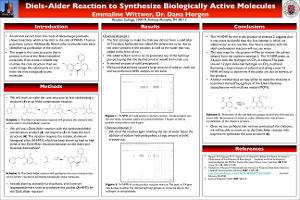Please use this identifier to cite or link to this item:
http://hdl.handle.net/10267/33435Full metadata record
| DC Field | Value | Language |
|---|---|---|
| dc.contributor.advisor | Horgen, Dana | - |
| dc.contributor.author | Wittwer, Emmaline A. | - |
| dc.date.accessioned | 2018-05-09T15:13:17Z | - |
| dc.date.available | 2018-05-09T15:13:17Z | - |
| dc.date.issued | 2018-04-27 | - |
| dc.identifier.uri | http://hdl.handle.net/10267/33435 | - |
| dc.description | Presentation by Emmaline Wittwer ('20) delivered at the Rhodes College Undergraduate Research and Creative Activity Symposium (URCAS). | - |
| dc.description.abstract | An ethanol extract from the roots of Boesenbergia pandurate shows bioactivity which is harmful to the cells of PANC-1 human pancreatic cancer. Additionally, fifteen other molecules have been identified via purification of the extract. Dr. Horgen's lab is working to synthesize these compounds. All of the target compounds have a similar core structure. We will work to make this core structure using a Diels-Alder reaction. This reaction will use a catalyst, aluminum hexagonal silica (Al-HMS), which will be synthesized from tetraethyl orthosilicate, aluminum isopropoxide and hexadecylamine. The use of this catalyst has been shown to lead to high yields in the Diels-Alder reactions between similar diene and chalcone dieneophiles. Finding a reliable way to make this core structure will provide the first step in a route to make the identified biologically active compounds that could be used to create an anticancer drug. | - |
| dc.subject | URCAS | - |
| dc.subject | Student research | - |
| dc.subject | 2018 Spring | - |
| dc.subject | Class of 2020 | - |
| dc.subject | Chemistry, Department of | - |
| dc.subject | Cancer | - |
| dc.title | Diels-Alder Reaction to Synthesize Biologically Active Molecules | - |
| dc.date.graduation | 2020 | - |
| Appears in Collections: | Undergraduate Research and Creative Activity Symposium | |
Files in This Item:
| File | Description | Size | Format | |
|---|---|---|---|---|
| 201804_Wittwer_Emmaline_DielsAlderReaction_Poster.pdf | 5.14 MB | Adobe PDF |  View/Open |
Items in DSpace are protected by copyright, with all rights reserved, unless otherwise indicated.